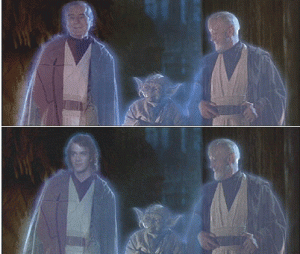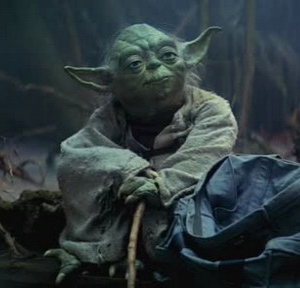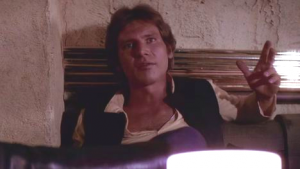Time is running out to see Star Wars in its entirety before you head to the theater for The Force Awakens! To help your viewing pleasure, we’re rerunning this recommended viewing order from Star Wars day this May. May the force be with you!
• • •
Star Wars is a cultural institution in modern society. Most people have seen it; many more than that could identify “Luke, I am your father” as a part of it (which is a misquote, by the way); virtually everyone has heard of it. But the fact that the six films were released out of order means you have to do a lot of verbal calisthenics when you’re talking about it. “I was watching Star Wars the other day…the fifth one…I mean, the second one…well, um…the one where the ending is sort of grim and the main character loses his hand…”
It’s no wonder that most fans refer to them by single-word appellations (Hope, Empire, Jedi, Phantom, Clones, Sith in release order). And most fans would tell you to watch them in that order, as the originals were certainly better films. But there are two big problems with that.
 Who’s that guy with Obi-Wan and Yoda? In 2004, Lucas replaced noted English actor Sebastian Shaw with Hayden Christensen in the finale of the film. Where before it was clear that the old man was intended to be Luke’s father, this young man’s appearance raises more questions than answers and appears to set up a sequel hook.
Who’s that guy with Obi-Wan and Yoda? In 2004, Lucas replaced noted English actor Sebastian Shaw with Hayden Christensen in the finale of the film. Where before it was clear that the old man was intended to be Luke’s father, this young man’s appearance raises more questions than answers and appears to set up a sequel hook.- Return of the Jedi could be better. The entirety of Return of the Jedi fails to capitalize on the tension contained in a single question that The Empire Strikes Back suggests: was Vader lying? Neglecting the question during the final film makes sense, but adding tension would make the final payoff – wherein Luke accepts Vader as his father – all the more satisfying.
A New Viewing Order
The solution that has been going around the internet recently is simple- watch the films in the following order:
A New Hope (Episode IV, released in 1977)
The Empire Strikes Back (Episode V, released in 1980)
The Phantom Menace (Episode I, released in 1999)
Attack of the Clones (Episode II, released in 2002)
Revenge of the Sith (Episode III, released in 2005)
Return of the Jedi (Episode VI, released in 1983)
This order posits that the prequel trilogy was never intended to be watched first, but was instead an extended flashback. I’ve watched the films in this order, also introducing them to my wife (who had previously not seen Star Wars) in this way, and we can both attest to the power of watching the films in this way. I’m even planning to show them to my son this way, when he’s old enough.
The Viewing Order Strikes Back
Why does The Flashback Order work better? For a few reasons.
- The best start and the best end. A New Hope is written with a much better introduction to the universe of Star Wars, and Return of the Jedi is a much more satisfying ending, than the prequel trilogy has to offer. Placing The Phantom Menace first or Revenge of the Sith last does a disservice to the franchise’s magic and wonder. In addition, the film starts with action and ends with action, and places the slower prequels in the middle.
- More surprises are maintained. Watching the prequel trilogy first kills the biggest spoiler in cinema history: that Darth Vader is actually Anakin Skywalker, Luke Skywalker’s father (it’s obvious when you consider the last name); it also kills the special joke that the “great Jedi” Yoda is actually a silly green guy. Watching the original trilogy first kills the (weaker) spoiler that Senator Palpatine is a Sith Lord who eventually becomes the Emperor. Using the prequels as a flashback preserves all of the spoilers.
- Better tension. Empire ends on one of the best cliffhangers in cinema history: how can the Rebellion possibly succeed? Sith ends on another really great one: how can Vader ever be redeemed after all the evil he’s done? Placing them both before their resolution in Jedi makes them more coherent and tense.
 Yoda is a much bigger player. One of the best characters in the franchise is Yoda, and placing his storyline all in a row makes his intense trepidation to train Luke, his contemplation while Luke is in the cave, and his warnings about Vader and the Emperor have a much greater impact than it does when separated. It makes Yoda a much more important part of the entire saga, fighting against the Dark Side from the very beginning and tragically dying, uncertain whether his lifelong fight was successful or not.
Yoda is a much bigger player. One of the best characters in the franchise is Yoda, and placing his storyline all in a row makes his intense trepidation to train Luke, his contemplation while Luke is in the cave, and his warnings about Vader and the Emperor have a much greater impact than it does when separated. It makes Yoda a much more important part of the entire saga, fighting against the Dark Side from the very beginning and tragically dying, uncertain whether his lifelong fight was successful or not.- Vader’s redemption is poignant. The climax of Sith shows Palpatine electrocuting one of Anakin’s former mentors while Anakin sits by and watches. At the end of Jedi, Vader watches his new master doing the same thing to his own son, and his decision to act has much greater weight to it.
- Luke’s journey is more powerful. At the end of Empire, Vader invites Luke to join him. Of course our hero would never turn to the dark side, right? But at the beginning of Jedi, Luke is wearing all black, force-choking Jabba’s guards, and seems almost at ease with Vader’s darkness. Maybe he did join his father, and is on the path to the dark side! When he mercilessly attacks his father in rage aboard the Death Star, our suspicions seem to be confirmed – and watching Jedi right after Sith highlights the similarities between Luke’s path and his father’s path, making for a much more satisfying moment when Luke abandons his rage and announces that he is a Jedi, like his father before him.
There are more reasons, but you get the gist: the Flashback Order is just a better way to watch it.
Return of the Viewing Order
Many people would insist that leaving Episode I out altogether is a better idea (making the order IV, V, II, III, VI); this is called the “Machete Order” (warning: mild language on that site). While I certainly see the reasons for doing so, the completionist in me just won’t allow me to watch the saga in that order. Simply placing the prequels amid the original trilogy is enough to fix the whole saga for me.
In addition, I never hated Episode I that much; II is my least favorite prequel. However, absent The Phantom Menace, Anakin’s tragic fall from grace feels a lot more manufactured since he seems to have been evil the entire time anyway. You really need Jake Lloyd’s performance to make his status as a Jedi believable. It makes Attack of the Clones a slightly better transition film.

So, there you go! As you plan your next Star Wars viewing party, consider watching it in the Flashback Order. I bet you’ll find it quite enjoyable. We’ll look into the theology of Star Wars soon; with the upcoming release of Episode VII, expect wall-to-wall coverage this December.
But for now, May The Force Be With You!

